Airports are getting bigger, challenging even the keenest travellers’ navigation skills. Emma Kelly reports on the wayfinding solutions helping get them to the gate on time.
With airports increasingly resembling small cities, and retail, F&B and entertainment space stretching as far as the eye can see, helping passengers navigate the terminal is more important than ever.
Fortunately, help is at hand, with a raft of apps, digital signs and wayfinding tools to ensure passengers arrive where and when they need to, improving their airport experience and providing benefits to airports, airlines and retail outlets along the way.
Digital is key
Today’s navigation is all about digital solutions. “Digital wayfinding solutions offer several advantages,” said Peter Asman, chief revenue officer at UK-based Living Map, “such as real-time updates, interactive maps, personalised direction and accessible routing, which can significantly enhance the overall passenger experience and provide valuable insight and operational benefits to the airport and airlines.”
Living Map’s Digital Connections Assistant is used by Star Alliance carriers, incorporated into the airline app, including Singapore Airlines at London Heathrow Airport. The service is being rolled out at other hubs, among then an unnamed European airport.
Working with airlines and airports, the company creates dynamic ‘living’ maps, tailored to customer branding and design requirements, providing passengers with custom-made routing and wayfinding features, including personalised assistance through notifications and directions based on a passenger’s flight details. The platform is built on accessibility and inclusivity, specifically designed to support disabled access. Asman says Living Map incorporates “state-of-the-art indoor positioning technology”, negating the need for beacons or dependency on any other hardware. “This innovation ensures accurate positioning and reliable navigation,” he added.
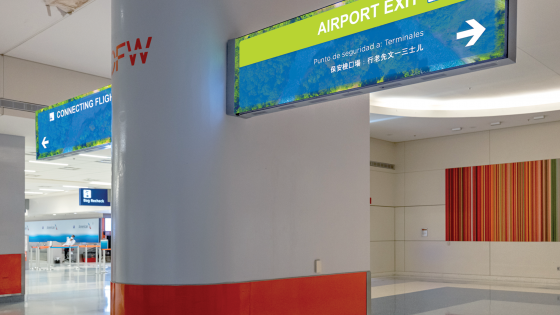
Dallas/ Fort Worth is using Passenger360 and smart, multilingual content to help domestic and international travellers find their way
Digital wayfinding solutions have revolutionised the wayfinding experience at airports, according to Asman. He told Airports International: “Travellers can easily navigate a complex airport using their smart device, minimising stress and confusion, ensuring they reach their gate in time. This makes for a happier shopper en route.”
Situm Indoor Positioning’s marketing manager, David Oreiro, expects digital wayfinding to become increasingly important due to these passenger benefits. He said: “Traditional wayfinding will not disappear, but digital solutions, whether with real-time location, static interactive maps or other types of solutions, will clearly be the most important because of their impact on the passenger experience and their potential to merge the digital and physical worlds.”
Signs have been very useful, but they are limited by the space available at airports
Situm’s wayfinding solutions are used at airport operator Aena’s facilities in Spain, including Madrid and Barcelona, as well as Berlin Brandenburg and airports in Asia, with Latin America and the Middle East to follow, added Oreiro, making use of pre-existing airport infrastructure. Incorporated in Aena’s app, Situm’s indoor guidance provides passengers with step-by-step information on their route, including estimated time of arrival and wait times at security checkpoints; notes on points of interest such as restaurants and shops; and adapted routes for travellers with reduced mobility.
This offers a raft of passenger benefits, said Oreiro, pointing to high personalisation and an improved passenger experience.
Greater flexibility
Sergio Morales, Appssenger product manager and chief technology officer, said: “Signs have been very useful, but they are limited by the space available at the airports and the amount of information they can display.
“With mobile devices and indoor wayfinding, the passenger doesn’t have to seek the desired sign and is able to get extended information on their desired destination,” he added.
The airport can provide the passenger with additional and more accurate information about the nearest facilities and services, as well as the quickest way to reach their boarding gate. “All of this information can be easily localised in different languages to create a stressless passenger experience,” Morales said.
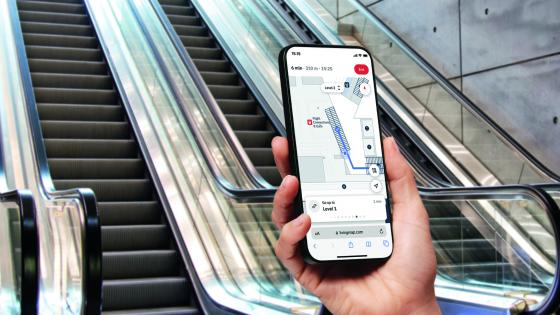
Digital wayfinding systems can generate a route based on specific criteria, such as avoiding stairs
Appssenger’s platform, which includes wayfinding, real-time flight updates and ancillary bookings, is currently used by Glasgow and Aberdeen airports, with the Appssenger mobile solution to be deployed by Ireland’s Shannon Airport and Trinidad and Tobago’s Piarco and ANR Robinson airports soon. Appssenger uses beacon technology because it is “very mature technology, requires low hardware and maintenance investment and can be reused for several purposes besides guidance, such as push notification, user tracking and other airport applications,” Morales explained.
The airport can use this engagement with the app to open a direct communication channel with the passenger for marketing actions using geofencing and notifications, increasing non-aeronautical revenues by providing the ability to book ancillaries and enhance the airport brand, said Morales. Airport operators can also create heat maps and passenger flows by anonymously tracking users’ movements inside the terminal.
Insights and engagement
Situm’s Oreiro points to the potential for increased engagement with passengers before, during and after their journey; optimising staff productivity with efficient workflows; boosting the profitability of commercial spaces; and targeting security and maintenance requirements in real time.
The data analytics provide airports with valuable insights into map usage and passenger movement, which in turn facilitates optimised terminal layouts, signage placements and overall flow for a more efficient and enjoyable experience, said Living Map’s Asman.
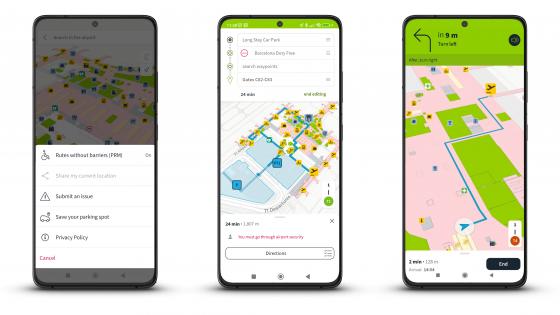
As part of Aena’s app, Situm’s indoor guidance provides passengers with step-by-step information on their route
Digital wayfinding solutions also deliver cost and energy savings, by optimising airport operations, streamlining passenger flow and minimising bottlenecks, reducing the need for staff in certain areas and cutting energy consumption through using fewer electronic displays, he added. The benefits are both operational and environmental, thanks to reductions in both passenger delays and airport congestion.
“While the implementation of digital wayfinding systems may require an initial investment, the long-term cost, energy and environmental benefits make it a worthwhile endeavour for airports and airlines alike,” said Asman.
Signs of change
Wayfinding signs are also changing with the times. Synect’s latest generation Passenger360 digital wayfinding solutions provide real-time information, interacting intelligently with airport data, providing live flight information and estimated walk times, ensuring smooth navigation.
Passenger360 is currently used at Orlando and Dallas Fort Worth international airports. At Orlando, the signs also feature QR codes, linking passengers to the airport’s app for turn-by-turn directions.
At Dallas, the multilingual Passenger360 signs display English and up to three other languages, which change based on the flight schedule and incoming flights’ country of origin, featuring animated visual messaging.
Synect’s ReadySeeGo portable units assist passengers in finding their way without any requirement for construction, installation of screens or wiring. “They can easily be placed at strategic locations to address specific challenges to wayfinding and passenger flow,” said CEO Yahav Ran.
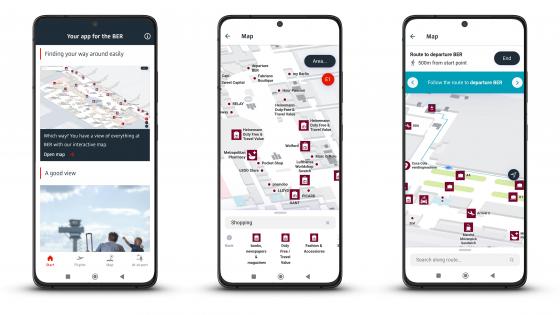
Visitors to Berlin Brandenburg Airport benefit from Situm’s indoor location technology, which has been incorporated into the airport’s app
“Digital wayfinding offers the advantage of interacting intelligently with airport data, including airline allocations, real-time flight updates, TSA wait times and more,” explained Ran, pointing to the delivery of automatic updates through integration with airport systems, multilingual messages based on flight schedules, dynamic wayfinding information, and integration with emerging technologies.
The digital screens can be constantly updated. Ran highlights 250 updates made at one client airport in the first half of 2023 alone – “which represents 250 opportunities to enhance sign messaging and functionality, react to new challenges and opportunities, and deliver a better passenger experience”.
Passenger360’s open architecture allows it to support creative and advanced scenarios meeting airports’ specific needs, said Ran, and means it can integrate with wayfinding apps. “Some of our innovation initiatives are poised to integrate with wayfinding apps,” he said.
Synect is always looking at new technology and how it can be used to improve the airport for everyone, Ran said, pointing to AI. Synect’s innovation lab is currently working on an AI implementation for an international airport to support wayfinding and more, he confirmed.
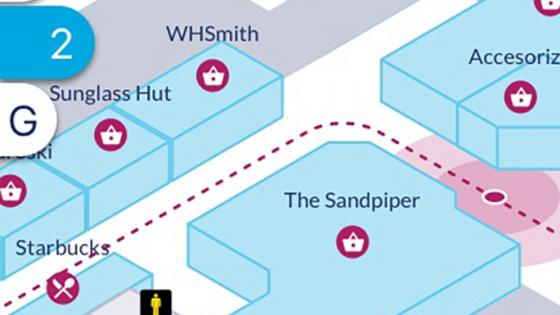
The Appssenger mobile solution uses beacon technology, which requires low hardware and maintenance investment
Situm, Appssenger and Living Maps are also on constant product development quests. “We are continuously introducing new features to make it easier for developers using Situm to implement this technology in their wayfinding apps,” Situm’s Oreiro told Airports International.
Greater accuracy
Appssenger is focused on improving location accuracy, Morales said: “Our team continues to improve the interactive isometric map, passenger wayfinding and wayfinding by seeking more accurate location of the user on the map, suggesting alternative concessionaires based on unit occupancy or giving the airport the ability to customise wayfinding to create routes that generate revenue opportunities.” While beacon-based wayfinding is good, Morales said the team is researching complementary technologies such as GPS for outdoors and Wi-Fi to improve indoor accuracy.
Technology is not adopted for technology’s sake – Asman said Living Maps has chosen not to focus on augmented reality in its near and medium-term roadmaps: “We believe that the technology, while impressive, cannot match the reach and accessibility that a standard mobile phone screen can provide,” he explained, concluding: “We have not completely ruled it out, but we feel that there needs to be a major industry hardware innovation before it can achieve a significant level of usefulness.”
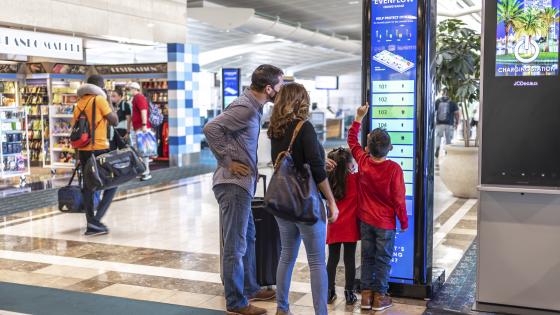
Synect’s next-generation visual communication system in use at Orlando International Airport (MCO)
Further reading: the smart trolley
Novel wayfinding solutions are emerging, including a smart baggage trolley from Intelligent Track Systems (ITS) that incorporates wayfinding via an interactive display and provides passenger flight details and information on shopping, toilets and food and beverage options.
Since mid-2022, successful trials have been conducted at San Diego, Nice, Oslo, Riyadh, Hamburg and Vienna airports, said Morten Pankoke, CEO, “with many more in the pipeline”.
Pankoke added: “The trolley’s airport airside mapping and real-time trolley positioning enable passengers to easily navigate their way around the airport.” Real-time flight information notifies passengers when their gate is announced and when boarding commences, providing a map and estimated time to get there.
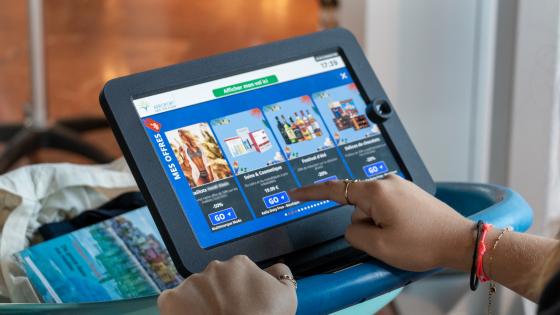
ITS’ trolley features both wayfinding and details of shopping, toilets and food and beverage options
The trolley’s wayfinding is powered by IndoorAtlas, highlighting nearby retailers, restaurants, gates and facilities, with the map using the airport Wi-Fi, the building’s magnetic field and Bluetooth beacons for accuracy. “We also use wayfinding tracking combined with boarding pass data, to create granular segmented heatmaps, which can be used as a strategic tool by airports and retailers,” he explained.
The product has been well received by passengers, with 91% of users saying they would use it again. The trolley is also proving beneficial for retailers, with heatmapping data confirming that promotion on the screens results in users spending “significantly more” on retail.
